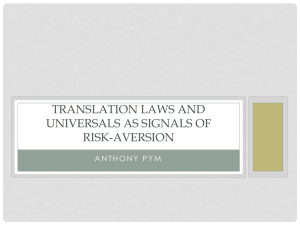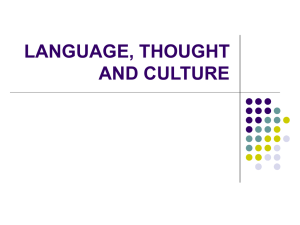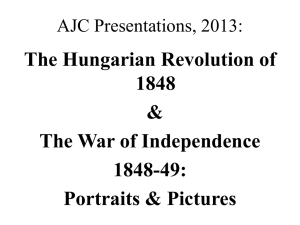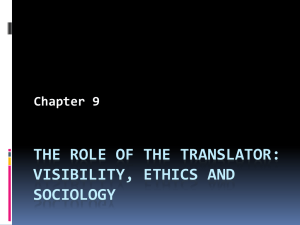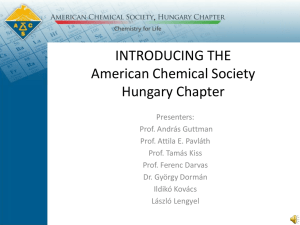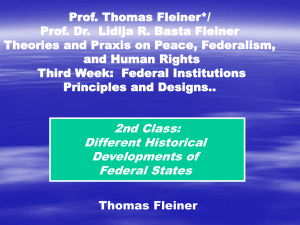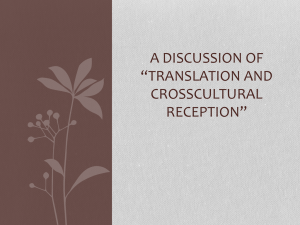Translation Studies - Erciyes University
advertisement
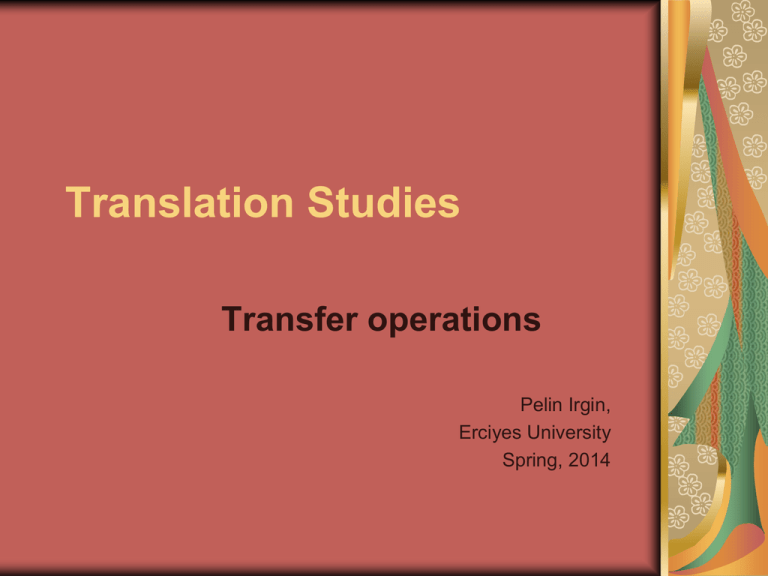
Translation Studies Transfer operations Pelin Irgin, Erciyes University Spring, 2014 1. Transfer operations from the point of view of the translator Classification of TOs was so far based on the “technical performance” of the operation (omission, addition, narrowing, broadening, etc.), linguistic (lexical, grammatical, stylistic) + extra-linguistic (cultural, historical, geographical, etc.) differences Present focus: translation as a special bilingual speech activity (characteristics of code switching natural losses, the role of redundancy, the role of the channel, etc.) the translator as a professional L mediator The main principles followed by translators as professional L mediators in their everyday work (1) The principle of following the TL norm aim = facilitate communication between two communities who speak different languages (= mediator role) translators develop certain characteristic forms of behaviour the translator follows certain general translation principles: - to take into consideration the TL reader. - to must follow the TL norms - to respect the SL text (2) The principle of cooperation translators tend to opt for the more explicit alternative explicitation (Blum Kulka 1986; Klaudy 1998a) = expressing something in the TL text in a clearer and more open manner, and possibly with the help of more words than in the SL text in seeking explicitation, the translator is guided by the principle of cooperation ( Grice (1975), because in translation the receiver is absent) the translator generally relies less on the readers' imagination than authors of original texts do, preferring to "play it safe" one means is by using the strategy of explicitation (3) The principle of following the translation norm the translator is not only a mediator, but also a professional one he/she has a profession/trade, with its own rules the immense translational experience of previous generations has always been handed down from one generation of translators to the next the principle of following tradition is also a principle that can guide translators in their decisions tradition is sometimes more highly valued by translators than the TL norm existence of a “translation norm” beside the target language norm General, specific and individual transfer strategies I. General transfer strategies the general principles (following the target language norm, the principle of cooperation, following the translation norm) imply certain general transfer strategies = particular series of transfer operations carried out consciously to transform the ST into the TL text EXPLICITATION as a general transfer strategy = “a process which consists of introducing information into the TL which is present implicitly in the SL, but it can be derived from the context or the situation” (Vinay and Darbelnet, 1995, p.352) Explicitation cont. Explicitation (implicitation) strategies are generally discussed together with addition (omission) strategies; 3 main views: some regard "addition" as the more generic and "explicitation" as the more specific concept (Nida 1964) others interpret "explicitation" as the broader concept which incorporates the more specific concept of "addition" (Seguinot 1988, Schjoldager 1995) the two are treated as synonyms by Englund Dimitrova who uses the terms "addition-explicitation" and "omissionimplicitation" (Englund Dimitrova 1993). Blum-Kulka (1986): examined explicitation systematically introduced the term "explicitation hypothesis" (1986) Blum-Kulka cont she explored discourse-level explicitation (= explicitation connected with shifts in cohesion and coherence i.e., overt and covert textual markers in translation shifts in cohesive markers can be partly attributed to the different grammatical systems of languages, and partly to the differences in stylistic preferences for various types of cohesive markers Blum-Kulka suggests that shifts on the level of cohesion may change the general level of the textual explicitness in the target text: Blum-Kulka cont. (citation) “The process of interpretation performed by the translator on the source text might lead to a TL text, which is more redundant than SL text. This redundancy can be expressed by a rise in the level of cohesive explicitness in the TL text. This argument may be stated as "the explicitation hypothesis", which postulates an observed cohesive explicitness from SL to TL texts regardless of the increase traceable to differences between the two linguistic and textual systems involved. It follows that explicitation is viewed here as inherent in the process of translation.” (1986, p.19) Critical remarks on Blum Kulka's explicitation hypothesis Seguinot (1988): finds the definition too narrow: states that explicitness does not necessarily mean redundancy argues that "the greater number of words in French translation, for example, can be explained by well-documented differences in the stylistics of English and French." (ibid.) She would reserve the term "explicitation" for additions, which cannot be explained by structural, stylistic or rhetorical differences between the two languages. II. Specific transfer strategies (1) Language specific transfer strategies the translator is not only a “professional mediator” but also a “language mediator” has developed his/her own individual strategies to overcome difficulties resulting from the differences between the two languages = language pair specific transfer strategies the facile and routine-like application of these transfer strategies distinguishes translators from simple monolingual speakers or from bilingual speakers who are not professional mediators. The basis of language specific transfer strategies is the routine-like use of transfer operations developed to overcome difficulties resulting from differences between languages. (2) Culture specific transfer strategies translators are not only linguistic but many times also “cultural mediators” it is also part of the translators’ professional competence that they know two cultures, and can compare and assess the geographical, historical, social, and cultural aspects of two language communities. The routine-like use of transfer operations developed by the translator to bridge cultural gaps serves as the basis for culture-specific transfer strategies. III. Individual transfer strategies during their translation practice, translators develop their own individual strategies as well. E.g., “chop up” the sentences, “augment” lexical elements (e.g., reporting verbs), “verbalise” structures. 2. The framework of an Indoeuropean-Hungarian transfer typology comparison of four Indo-European languages (English, French, German, and Russian) with Hungarian (a Finno-Ugric language) despite the systemic differences inside the IE group, they are treated together in relation to Hungarian based on (1) the literature on language typology, (2) experiences of practising translators, editors of translations and translator trainers, (3) the evidence of the corpus Language-typological reasons The lexical and grammatical systems of the four IE languages under investigation differ in similar ways in their basic features from the lexical and grammatical system of Hungarian: Language typological reasons cont. IE = analytical morphological and lexical structuring; H = synthetic morphological and lexical structuring, synthetic sentence structuring in IE languages vs. analytical sentence structuring in Hungarian dominantly SVO basic word order in IE languages vs. dominantly SOV basic word order in Hungarian the complementation of nominal structures to the left in Hungarian vs. their complementation to the right in IE languages, subject-prominence in English vs. topicprominence in Hungarian, etc. Experience as a practising translator Intuitive, experience-based “witty” observations of translators strongly resemble one another. Differences between Hungarian and IE languages: Intuitive observations cont. (1) " Hungarian likes to use verbs when IE languages use nouns." (2) " Hungarian likes to use active when IE languages use passive." (3) "When you translate from IE languages into Hungarian you have to begin the translation from the end of the sentence." (4) "Hungarian cannot manage the long chains of complements in preposition to the nouns." (5) "IE languages force Hungarian to use this long nominal chain, but we do not like it." (6) "IE languages cannot evoke the whole richness of Hungarian verbs." (7) "When translating form Indo-European languages an impoverishment of the Hungarian language takes place against which translators have to fight etc." Evidence of the corpus The data collected confirmed the assumption that the four Indo-European languages in many aspects “contrasted” with Hungarian in a similar way. E.g., first page of a Budapest travel guide published by Corvina Publishing Company Hol is kezdjük? (lit: Where shall we start?) (Bart 1) Where shall we begin our journey? (Gorman 1) Par ou commencer notre flanerie? (Chehádé 1) Wo sollen wir unseren Spaziergang beginnen? (Dira 1) Otkuda nachat’ nasu progulku? (Voronkina 1) The sources of the examples five languages (English, French, German, Russian and Hungarian) eight directions of translation (English Hungarian, Hungarian English, French Hungarian, Hungarian French, German Hungarian, Hungarian German, Russian Hungarian, Hungarian Russian) texts - approx. 50 English, 50 French, 50 German, and 50 Russian literary works and their Hungarian translations - about 100 Hungarian literary works and their 25 English, 25 French, 25 German, and 25 Russian translations - 600 literary works have been examined authors: Dickens, Balzac, Thomas Mann, Pasternak, Mikszáth, Krúdy, Örkény ***
